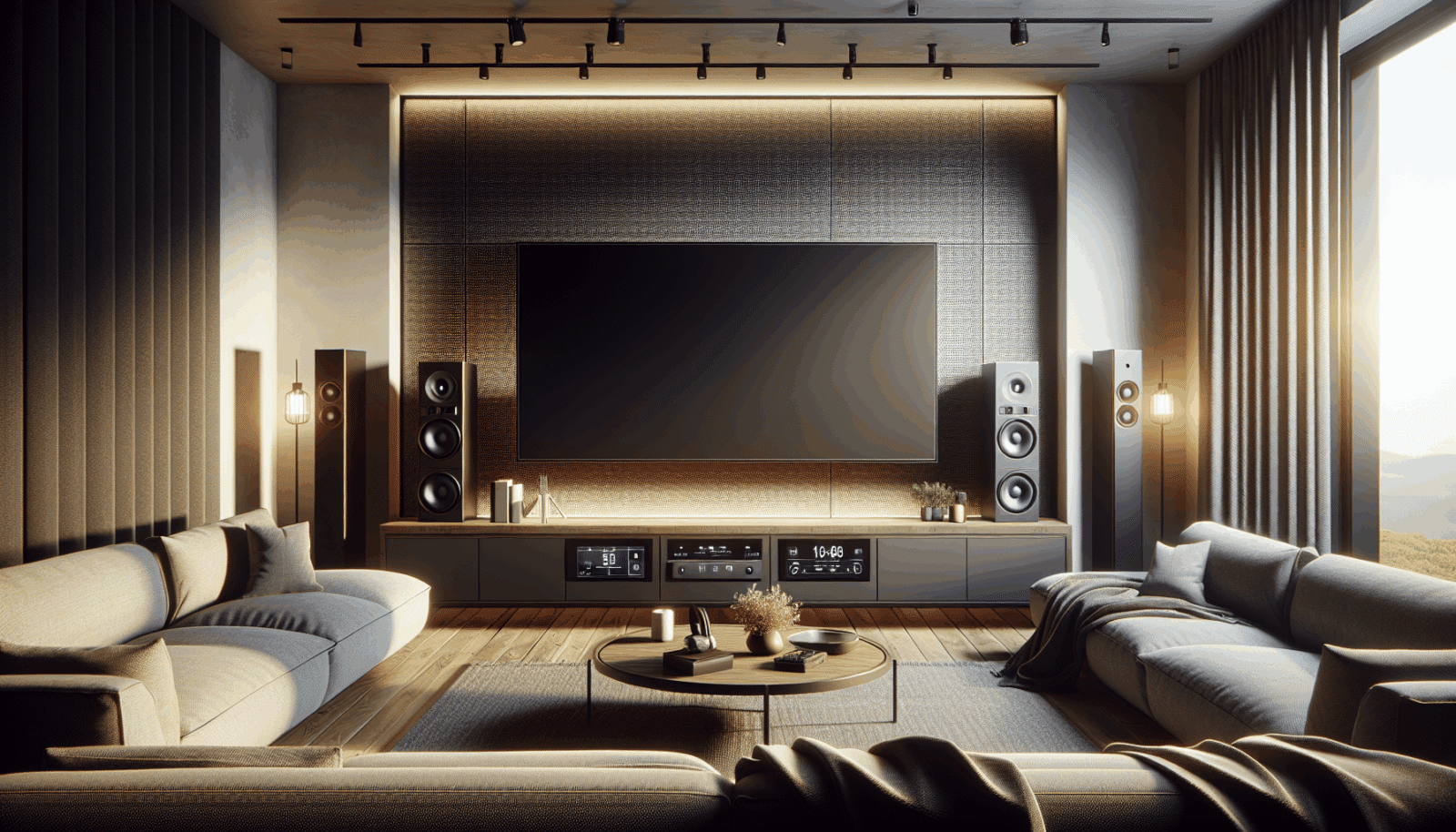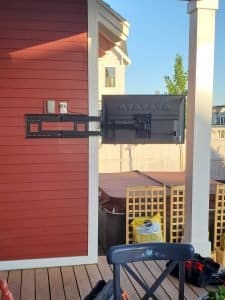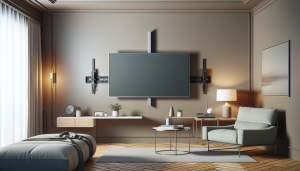Many homeowners dream of creating the perfect home theater experience, but find that even with the best TV, the sound just doesn’t measure up. Fortunately, you don’t have to settle for subpar audio any longer. Here at Utah TV Mounting, we specialize in elevating your viewing experience beyond just crystal-clear pictures to immersive, theater-quality sound right in your living room. Our guide will unveil the secrets to enhancing your TV acoustics experience, inviting you to dive into a world where sound brings your favorite shows and movies to life.
Contents
- 1 Understanding the Basics of TV Acoustics
- 2 The Importance of Speaker Placement
- 3 Optimizing Your Room’s Acoustics
- 4 Enhancing Sound with Soundbars and Receivers
- 5 Understanding Surround Sound Formats
- 6 Subwoofers: The Key to Deep Bass
- 7 Calibrating Your System for Optimal Sound
- 8 The Role of Audio Cables and Connections
- 9 Tips for Upgrading Your Sound System
- 10 Conclusion
Understanding the Basics of TV Acoustics
Before jumping into complex solutions, it’s essential to grasp the fundamentals of TV acoustics. Sound quality can be influenced by several factors, including the physical characteristics of your TV, the room’s acoustics, and where you place your speakers. Most flat-panel TVs come with built-in speakers that face downwards or backwards, leading to muffled sound. By understanding these basics, you’re taking the first step towards transforming your audio experience.
Moreover, the room itself plays a critical role. Hard surfaces can reflect sound, causing echo, while soft surfaces may absorb it, leading to clearer but quieter audio. Recognizing these factors gives you control over your sound environment, allowing for an improved acoustical experience.
The Importance of Speaker Placement
Speaker placement is pivotal in maximizing your TV’s sound quality. Ideally, speakers should be at ear level when seated. This position ensures that sound travels directly to the listener without unnecessary reflection or absorption. For an even more immersive experience, consider positioning surround sound speakers around your seating area.
Additionally, the distance between speakers can significantly affect the audio. Speakers too far apart may create a disjointed sound, while those too close can lead to a more mono-like experience. Striking the perfect balance is key to achieving optimal acoustics within your home entertainment setup.
Optimizing Your Room’s Acoustics
Adjusting your room’s layout can profoundly impact sound quality. Begin by minimizing hard surfaces that cause echo and reverb. Rugs, curtains, and upholstered furniture can soften these effects, leading to clearer audio. If possible, rearrange your seating to avoid direct sound path obstructions, providing an unimpeded audio experience from speaker to ear.
In rooms with especially challenging acoustics, consider installing acoustic panels. These panels are designed to absorb sound, prevent echoes, and reduce noise, creating a more sonically agreeable environment for your home theater.
Enhancing Sound with Soundbars and Receivers
One of the simplest yet most effective ways to improve your TV’s audio is through the addition of a soundbar or receiver. Soundbars offer a compact, efficient way to enhance dialogue clarity and widen the soundstage without requiring a full speaker setup. For those seeking the ultimate audio experience, a receiver connected to multiple speakers can transform your living room into a cinematic paradise.
When choosing a soundbar or receiver, consider compatibility with your existing TV and audio equipment. Look for features such as Bluetooth connectivity, which allows for wireless streaming, adding flexibility to your entertainment system.
Understanding Surround Sound Formats
Surround sound formats like Dolby Atmos and DTS:X take the concept of audio immersion to new heights. These technologies use advanced algorithms to create a 3D sound environment, making it feel as though the action is happening all around you. To fully benefit from these formats, you’ll need compatible equipment and content.
Familiarizing yourself with these surround sound formats enables you to make informed decisions about your home theater system investments, ensuring you select components that match your desired audio experience.
Subwoofers: The Key to Deep Bass
For those craving the rumble of deep bass, incorporating a subwoofer into your audio setup is a must. Subwoofers are designed to reproduce low-frequency sounds, adding depth and richness to explosions, music, and dramatic scenes. Placing your subwoofer correctly—in a corner or along the front wall—can maximize its performance.
Remember, the goal is to blend the subwoofer’s output with your other speakers seamlessly, creating a balanced sound field that envelopes the listener without overwhelming them with bass.
Calibrating Your System for Optimal Sound
After setting up your speakers and audio equipment, calibration is crucial. Many modern receivers come with automatic calibration systems that analyze and adjust the audio characteristics of each speaker. This process ensures balanced volume levels and optimal sound distribution throughout the room.
Manual adjustments can further refine your system’s sound. Experiment with settings like treble, bass, and speaker levels to match your personal preferences and room’s acoustic properties. With patience and precision, calibration brings out the best in your home theater’s audio setup.
The Role of Audio Cables and Connections
Audio cables and connections might seem like minor details, but they significantly affect sound quality. High-quality cables can reduce signal loss and interference, ensuring crisp, clear audio. It’s essential to use the correct type of cable for each component, whether it’s HDMI, optical, or coaxial.
Moreover, ensuring secure connections is critical. Loose connections can lead to sound dropouts or static. Regularly check and maintain your cables and ports to preserve the integrity of your audio system.
Tips for Upgrading Your Sound System
- Research before purchasing: Explore reviews and specifications to find the best fit for your needs and budget. The perfect sound system for someone else might not be the right choice for you.
- Consider future expansions: Invest in components that offer expandability. This foresight allows you to enhance your system as technology advances or your budget allows.
- Test in your environment: If possible, test new equipment in your home. Audio equipment can perform differently in various spaces, affecting your satisfaction with the product.
- Professional installation and calibration: For the best outcome, consider professional installation and calibration. Experts like us ensure your system is set up for peak performance.
- Regular maintenance: Keep your system clean and check connections regularly. Simple upkeep can significantly extend the life and quality of your home theater setup.
Conclusion
If you’re ready to take your home entertainment to the next level, Utah Tv Mounting is here to help. From choosing the right equipment to professional installation and calibration, we’ve got you covered. Enhance your TV acoustics experience by reaching out to us by phone at 801-383-0493 or Request a Free Quote today.




